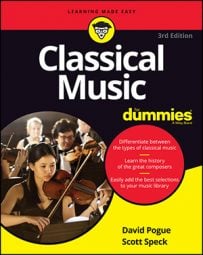Antonio Vivaldi (1678–1741), Italian classical music celebrity of the Baroque period, worked for the Catholic Church. Talk about prolific: This guy wrote more music in his lifetime than just about anyone else on the planet. Aside from his 50 operas, more than 40 pieces for choir and orchestra, and 100 works for orchestra alone, he wrote nearly 500 concertos for various solo instruments with orchestra. Vivaldi’s caffeine consumption must have been prodigious.
Now, some of Vivaldi’s jealous critics — and they’re still around today — snipe that Vivaldi actually wrote the same piece of music 500 times. Balderdash! Why would anyone write the same piece 500 times? What a waste of effort.
Vivaldi’s music does have a very consistent style, however — hence the accusation that it all sounds alike.
The little priest that couldn’t
Vivaldi grew up in Venice; after he came of age, he decided to enter the priesthood. This decision, plus his blazing red hair, gave him the nickname “The Red Priest.”
But Vivaldi didn’t last very long as a priest; stories of his misadventures abound. One day during Mass, for example, a great tune popped into his head. Without hesitation or apology, he stepped down from the altar and dashed into the next room to get the tune on paper. The congregation was stunned. (It didn’t take much to stun a congregation in those days.)
Vivaldi was brought before a tribunal to determine his punishment. Luckily, the Inquisition was in a good mood. Its verdict: Genius Gone Awry. The punishment: Vivaldi was not allowed to say Mass ever again.This was probably perfectly okay with him.
And so the Red Priest became simply Red.
The Wayward Girls Philharmonic
Vivaldi’s next job lasted 35 years, until the end of his career. He became a violin teacher at the Ospedale della Pietà (literally, “Mercy Hospital”). This was a unique hybrid institution: It was a conservatory of music/school for illegitimate girls. No institution in America today — not even the Juilliard School — can make this claim.
Over the years, Vivaldi gradually took on more and more duties at the Ospedale, until he was practically running the place. He organized weekly concerts that became renowned throughout Europe. Whenever he wanted to show off the musical talents of one girl or another, he would simply write a concerto (“con-CHAIR-toe”) for her.
Vivaldi’s concertos have three movements, and they all follow a set format, which became the model for many other Baroque composers. Here’s the formula:
Fast — Slow — Fast
Listening to Vivaldi’s music
You’ve likely nheard the music of Vivaldi, especially his most famous piece ever: The Four Seasons. It’s a set of four concertos for a violin with orchestra, in which each concerto evokes the feeling of a different season.
Spring is full of bird songs, a quick thunderstorm with lightning, a sleeping goatherd complete with barking dog, dancing shepherds, and nymphs. (Especially nymphs.) In Summer, you feel the heat of the burning sun; you hear the cuckoo; you get a few mosquito bites; and you experience the full force of a fluke hailstorm.
Autumn begins with a drunken harvest bacchanal and ends with a wild hunt, complete with simulated hunting horns. And in Winter, you freeze; you shiver; you stamp your feet; you sit by the fireside for warmth; and then you go outside again, only to slip and fall through the ice. Kind of sadistic, actually. All this feeling comes through wonderfully in the music.
Many classical music enthusiasts love The Four Seasons; so do the countless commercials, movies, and TV shows that have incorporated this music. It’s a great piece to own; go get it.
And if you’re hungry for more, try these tasty tidbits:
Concerto for Guitar in D major, RV 93
Concerto for Two Trumpets in C major, RV 537
Sonata for Two Violins, RV 60
Gloria (oratorio for three solo singers, chorus, and orchestra), RV 589
Concerto for Two Cellos in G minor, RV 531
Double Orchestra Concerto, RV 585
Notice that, in the preceding list, the title of each work is followed by an RV catalog number, which helps you locate the piece in a record store. This number refers to the number of times that you could fit that piece, end to end, into a standard recreational vehicle.

